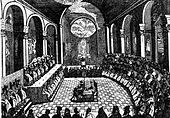First Council of Lyon
| First Council of Lyon | |
|---|---|
| Date | 1245 |
| Accepted by | Catholic Church |
Previous council | Fourth Council of the Lateran |
Next council | Second Council of Lyon |
| Convoked by | Pope Innocent IV |
| President | Pope Innocent IV |
| Attendance | 250 |
| Topics | Emperor Frederick II,clerical discipline,Crusades,Great Schism |
Documents and statements | thirty-eight constitutions, deposition of Frederick,Seventh Crusade,red hat forcardinals,levy for the Holy Land |
| Chronological list of ecumenical councils | |
| Part ofa serieson the |
| Ecumenical councils of theCatholic Church |
|---|
 |
| 4th–5th centuries |
| 6th–9th centuries |
| 12th–14th centuries |
| 15th–16th centuries |
| 19th–20th centuries |
|
|

TheFirst Council of Lyon(Lyon I) was the thirteenthecumenical council,as numbered by theCatholic Church,taking place in 1245.
The First General Council of Lyon was presided over byPope Innocent IV.Innocent IV, threatened byHoly Roman EmperorFrederick II,arrived at Lyon on2 December1244, and early the following year he summoned the Church's bishops to the council later that same year. Some two hundred and fifty prelates responded including the Latin Patriarchs ofConstantinople,Antioch,andAquileia(Venice) and 140 bishops. The Latin emperorBaldwin II of Constantinople,Raymond VII, Count of Toulouse,andRaymond Bérenger IV, Count of Provencewere among those who participated. With Rome under siege by Emperor Frederick II, the pope used the council toexcommunicateand depose the emperor withAd Apostolicae Dignitatis Apicem,[1]as well as thePortuguese KingSancho II.[2]The council also directed a new crusade (theSeventh Crusade), under the command ofLouis IX of France,to reconquer theHoly Land.[3]
At the opening, on 28 June, after the singing of theVeni Creator Spiritus,Innocent IV preached on the subject of the five wounds of the Church and compared them to his own five sorrows: (1) the poor behaviour of bothclergyandlaity;(2) the insolence of theSaracenswho occupied the Holy Land; (3) the GreatEast-West Schism;(4) the cruelties of theTatarsin Hungary; and (5) the persecution of the Church by the Emperor Frederick.
The council of Lyon was rather poorly attended. Since the great majority of those bishops and archbishops present came from France, Italy and Spain, while theByzantine Greeksand the other countries, especiallyGermany,were but weakly represented, the ambassador of Frederick, Thaddaeus of Suessa, contested itsecumenicityin the assembly itself.[4]In a letter, Innocent IV had urgedKaliman I of Bulgariato send representatives. In the bullCum simus super(25 March 1245), he also urged theVlachs,Serbs,Alans,Georgians,Nubians,theChurch of the Eastand all the other Eastern Christians not in union with Rome to send representatives. In the end, the only known non-Latin cleric present was Peter, thebishop of Belgorodand vicar of themetropolitanate of Kiev,who provided Innocent with intelligence on the Mongols prior to the council. His information, in the form of theTractatus de ortu Tartarorum,circulated among attendees.[5]
The condemnation of the emperor was a foregone conclusion. The objections of the ambassador, that the accused had not been regularlycited,that the pope was plaintiff and judge in one, and that therefore the whole process was anomalous, achieved as little success as his appeal to the future pontiff and to a truly ecumenical council.[6]
At the second session on 5 July, thebishop of Calviand a Spanish archbishop attacked the emperor's behaviour, and in a subsequent session on 17 July, Innocent pronounced the deposition of Frederick. The deposition was signed by one hundred and fifty bishops and theDominicansandFranciscanswere given the responsibility for its publication. However, Innocent IV did not possess the material means to enforce the decree.
The Council of Lyon promulgated several other purely disciplinary measures:
- It obliged theCisterciansto paytithes
- It approved the Rule of theGrandmontines
- It decided the institution of the Octave of the Nativity of the Blessed Virgin
- It prescribed thatcardinalswere to wear a red hat[7]
- It prepared thirty-eight constitutions which were later inserted byBoniface VIIIin his Decretals, the most important of which decreed a levy of a twentieth on every benefice for three years for the relief of the Holy Land.[8]
Among those attending wasThomas Cantilupewho was made a papal chaplain and given a dispensation to hold his benefices in plurality.[9]
References[edit]
- ^Bellitto 2002,p. 57.
- ^Martínez 2010,p. 380.
- ^Addington 1994,pp. 59–60.
- ^Biller 2000,pp. 229–230.
- ^Maiorov 2019,pp. 10–11.
- ^Mirbt 1911,p. 177.
- ^Richardson 2019,p. 541.
- ^Dondorp & Schrage 2010,p. 44.
- ^Ambler 2017,p. 148.
Sources[edit]
- Addington, Larry H. (1994).The Patterns of War Through the Eighteenth Century.Indiana University Press.ISBN978-0253205513.
- Ambler, S. T. (2017).Bishops in the Political Community of England, 1213–1272.Oxford University Press.ISBN978-0198754022.
- Bellitto, Christopher M. (2002).The General Councils:A History of the Twenty-One Church Councils from Nicaea to Vatican II.Paulist Press.ISBN978-0809140190.
- Biller, Peter (2000).The Measure of Multitude: Population in Medieval Thought.Oxford University Press.ISBN978-0198206323.
- Dondorp, Hary; Schrage, Eltjo J.H. (2010). "The Sources of Medieval Learned Law". In Cairns, John W.; du Plessis, Paul J. (eds.).The Creation of the Ius Commune: From Casus to Regula.Vol. 7. Edinburgh University Press.ISBN978-0748638970.
- Hefele, Karl Joseph von (1913). H. Leclercq (tr.).Histoire des conciles d'après les documents originaux.(in French and Latin).Vol V, part 2.Paris: Letouzey, 1913.
- Maiorov, Alexander V. (2019). "The Rus Archbishop Peter at the First Council of Lyon".The Journal of Ecclesiastical History.71(1): 1–20.doi:10.1017/s0022046919001143.S2CID211652664..
- Martínez, H. Salvador (2010).Alfonso X, the Learned.Translated by Cisneros, Odile. Brill.ISBN978-9004181472.
- This article incorporates text from a publication now in thepublic domain:Mirbt, Carl Theodor(1911). "Lyons, Councils of".InChisholm, Hugh(ed.).Encyclopædia Britannica.Vol. 17 (11th ed.). Cambridge University Press. pp. 176–177.
- Richardson, Carole M. (2019). "The Cardinal's Wardrobe". In Hollingsworth, Mary; Pattenden, Miles; Witte, Arnold (eds.).A Companion to the Early Modern Cardinal.Brill. pp. 535–556.ISBN978-9004310964.
- Wolter, Hans; Holstein, Henri (1966).Histoire des conciles œcuméniques: Lyon I et Lyon II.(in French).Pars: Éditions de l'Orante, 1966.
